Complete with a taste test by our resident Flavor Scientist, we found the best egg substitutes after trying out all the popular options. From cakes to spätzle, read on to find out the best way of replacing eggs in virtually every scenario. You'll use these vegan egg substitutes all the time!
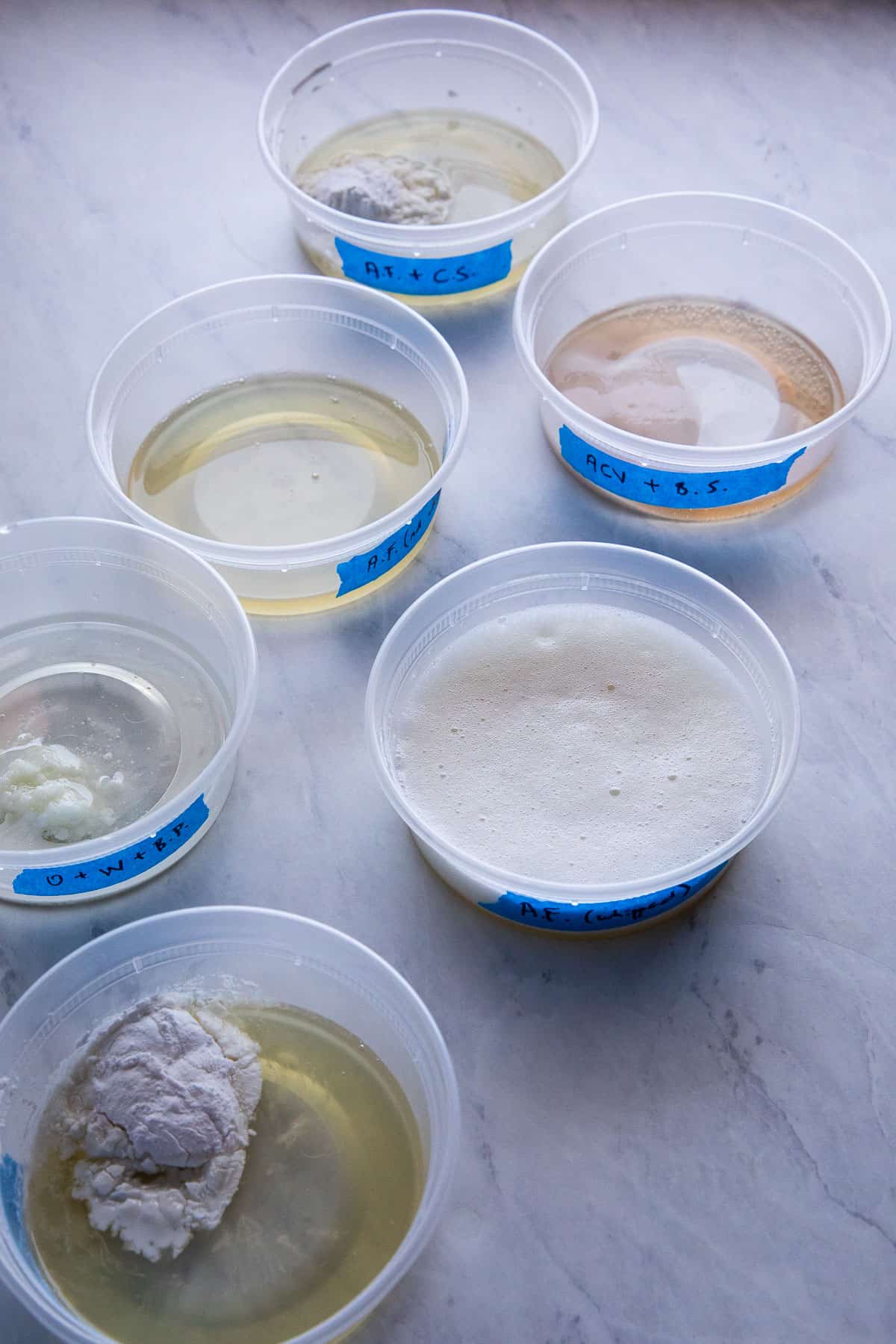
Are you also unwilling to waste one more batch of batter trying to replace eggs? Follow this guide and figure out which substitute to use in each situation!
Skip directly to the "How to Replace Eggs in Anything" section for the quickest answers.
First, we'll go over the macronutrient profile of eggs and figure out what they bring to the table in baking and cooking.
Then we'll discover the pros and cons of each substitute and reveal the results of our test.
By the end, you'll know which application may work best for different baked goods and more.
Jump to:

🥚 What's an Egg Made of?
In order to substitute a chicken egg in the best way and guess how we can mimic its properties, we will zoom in on its contents first.
Disclaimer: This part can be a bit boring. Also, please keep in mind that all values used in this section are approximate and have been taken from Cronometer—our favorite online nutrition calculator.
One medium egg weighs approximately 45 grams and has 70 calories from 6 grams of protein, 5 grams of fat (1.4 gram of which is saturated), and less than 1 gram of carbohydrates.
Almost 75% of an egg's weight is from water (33 grams). Of the 70 calories in a medium-sized egg, 62% are from fats, 36% are from protein, and the remaining 2% are from carbohydrates.

Although chicken eggs have many different parts in their anatomy such as various membranes, shell, and chalazae, we'll only explore the most relavant: the albumen (egg white) and the yolk.
Egg White
The egg white from one medium egg weighs about 30 grams and has 3 grams of protein and less than a gram of fats and carbohydrates each. 90% of a chicken egg's albumen is water.
Egg Yolk
Egg yolk from one medium egg weighs about 15 grams and has 5 grams of fats, 3 grams of protein, and less than a gram of carbohydrates.
🥣 Why Do We Use Eggs in Baking and Cooking?
Sorry, I threw way too many numbers at you... but they matter! Now let's see what each component provides in baking:
Protein:
In most applications, protein seems to be the most important component of an egg.
This is mostly because proteins are capable of denaturing: the process of proteins breaking down and creating new bonds, making new structures as they rebuild.
If the proteins are broken down via whisking, the egg white forms a foam with trapped air that can withstand its own weight.
The proteins can also be broken down via heat, forming a solid texture from cooking.
Moreover, proteins are also very good emulsifying agents—they get in the way of tiny fat molecules and prevent them from coalescing in presence of water.
In short, the protein found in eggs helps in providing structure, emulsification, binding, and leavening.
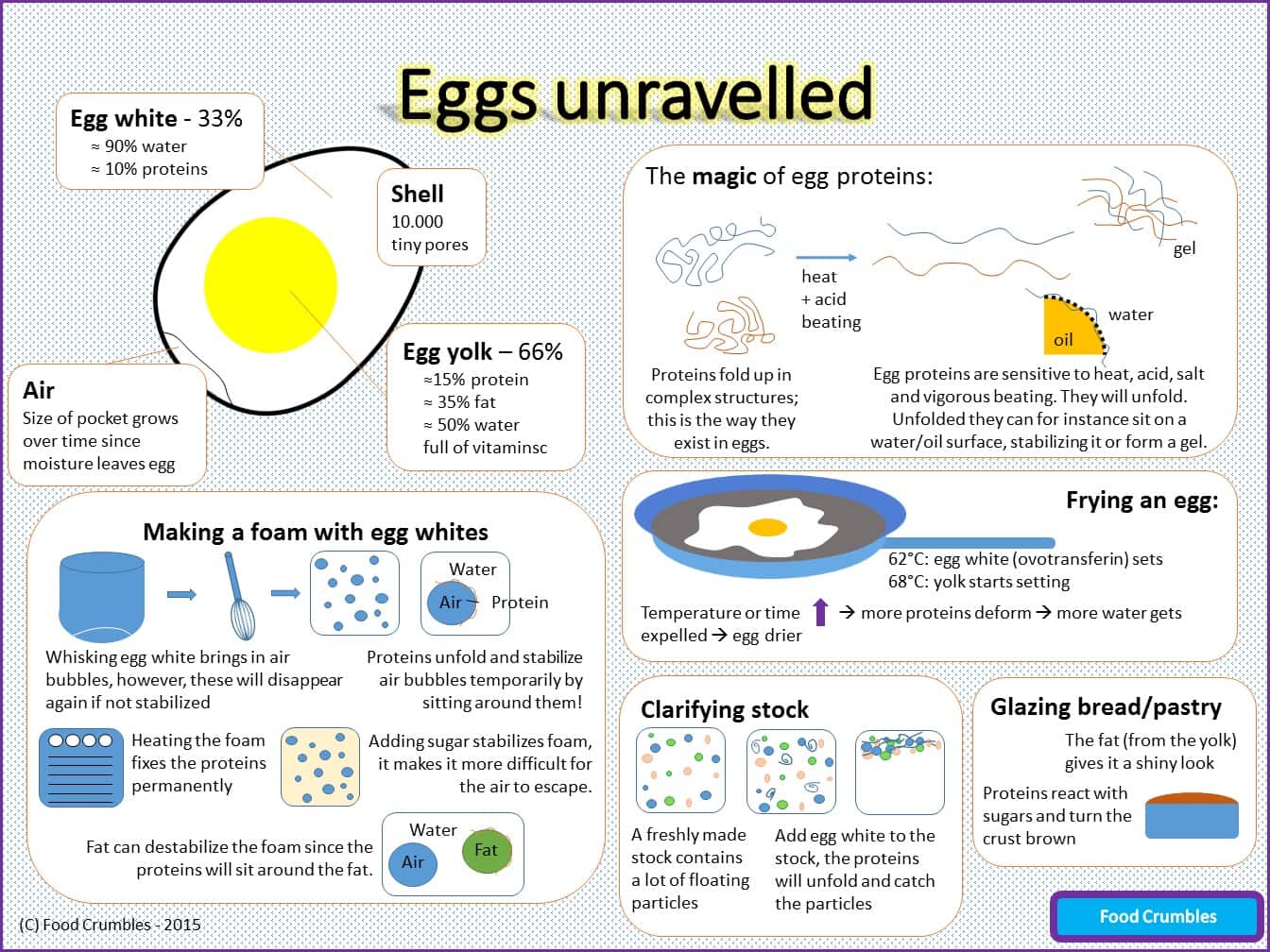
Fat:
Adding fats to baked goods, also known as shortening, increases flakiness and makes them more tender.
Considering that one egg has 5 grams of fat, about equal to ½ tablespoon of butter, omitting the fat in an egg replacer altogether may have a less than ideal outcome.
Water:
Remember how we said almost 75% of an egg is water? That's a lot.
This is why if you fail to replace the water when using a substitute, you'll end up with a different hydration percentage in the batter... which will result in vastly different levels of moisture in baked goods depending on the recipe.
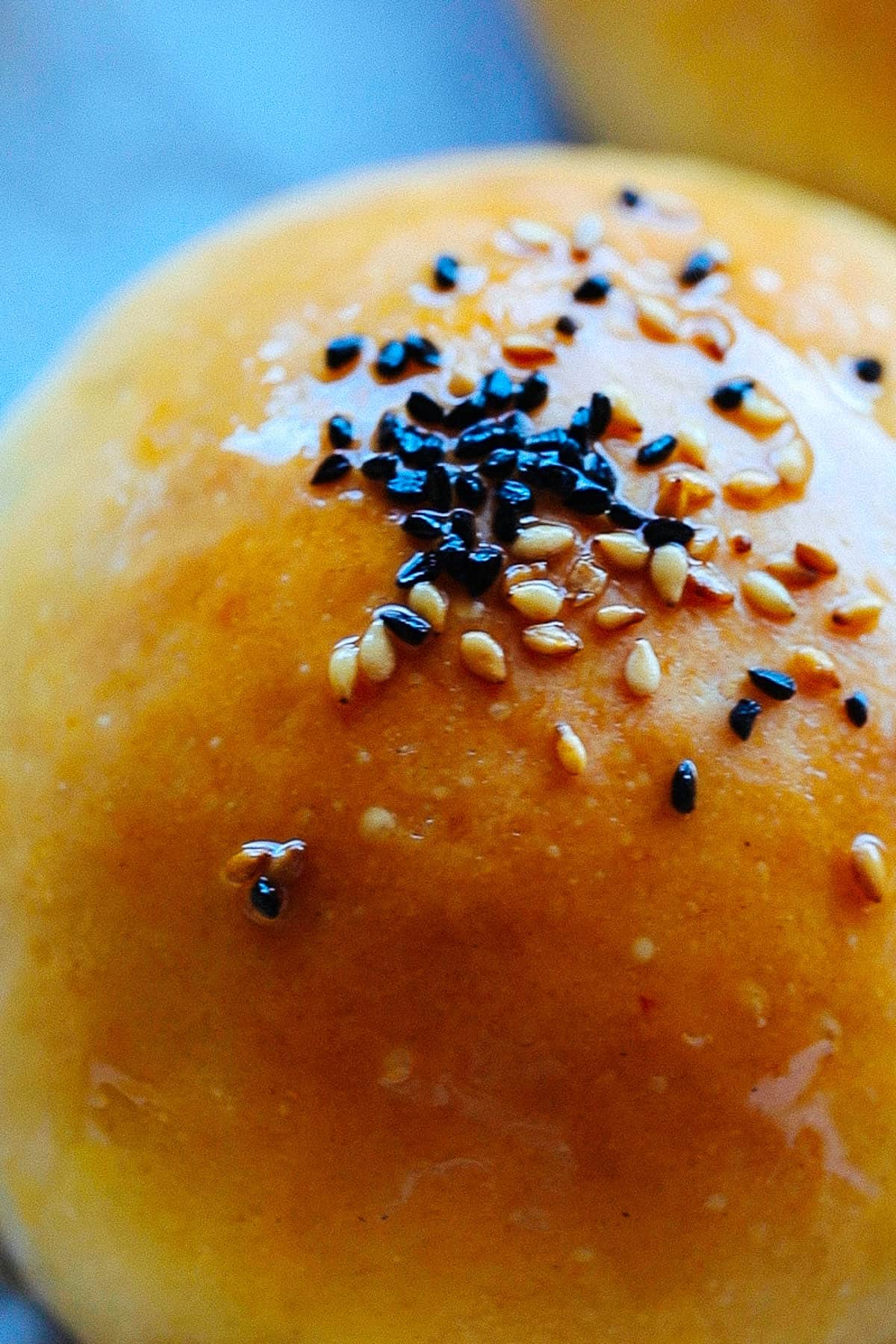
Eggs' Other Properties
Eggs have yellow/orange pigments that can change the color of what you make. This is especially important when making an "egg glaze", where the entire purpose is to add color.
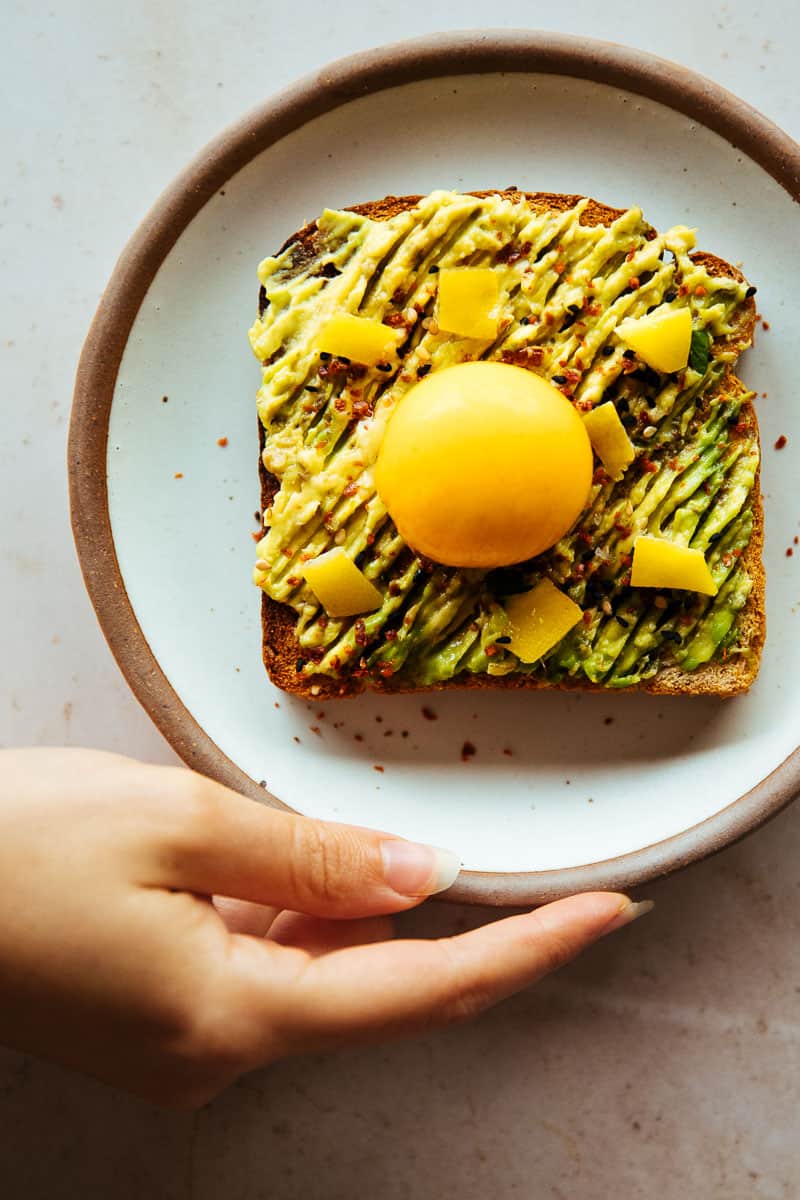
Lastly, eggs have unique flavor compounds that are almost impossible to replicate without using commercial lab-made flavors.
Luckily, most baked goods don't require using as high a percentage of eggs where their lack would result in too obvious a change in flavor.
Now that we know what eggs are made of and what they do in baking, let's construct the test and reveal the results!

🧪 Test Methodology
We all know that eggs are used for different purposes in different recipes. So why did I choose to test its best substitute with a cake recipe?
That's because cakes have given me the most problems when using egg replaces.
Angel food, creamed butter, genoise—they each require a different approach to substituting eggs that is difficult to pinpoint without knowing what the egg is used for exactly.
All in all, this is not a perfect test and I can think of a million ways to improve upon it, but the results do match my initial hypothesis.
The winning egg replacer works in almost every baked good I've tried making with it—you just need to make some subtle tweaks!
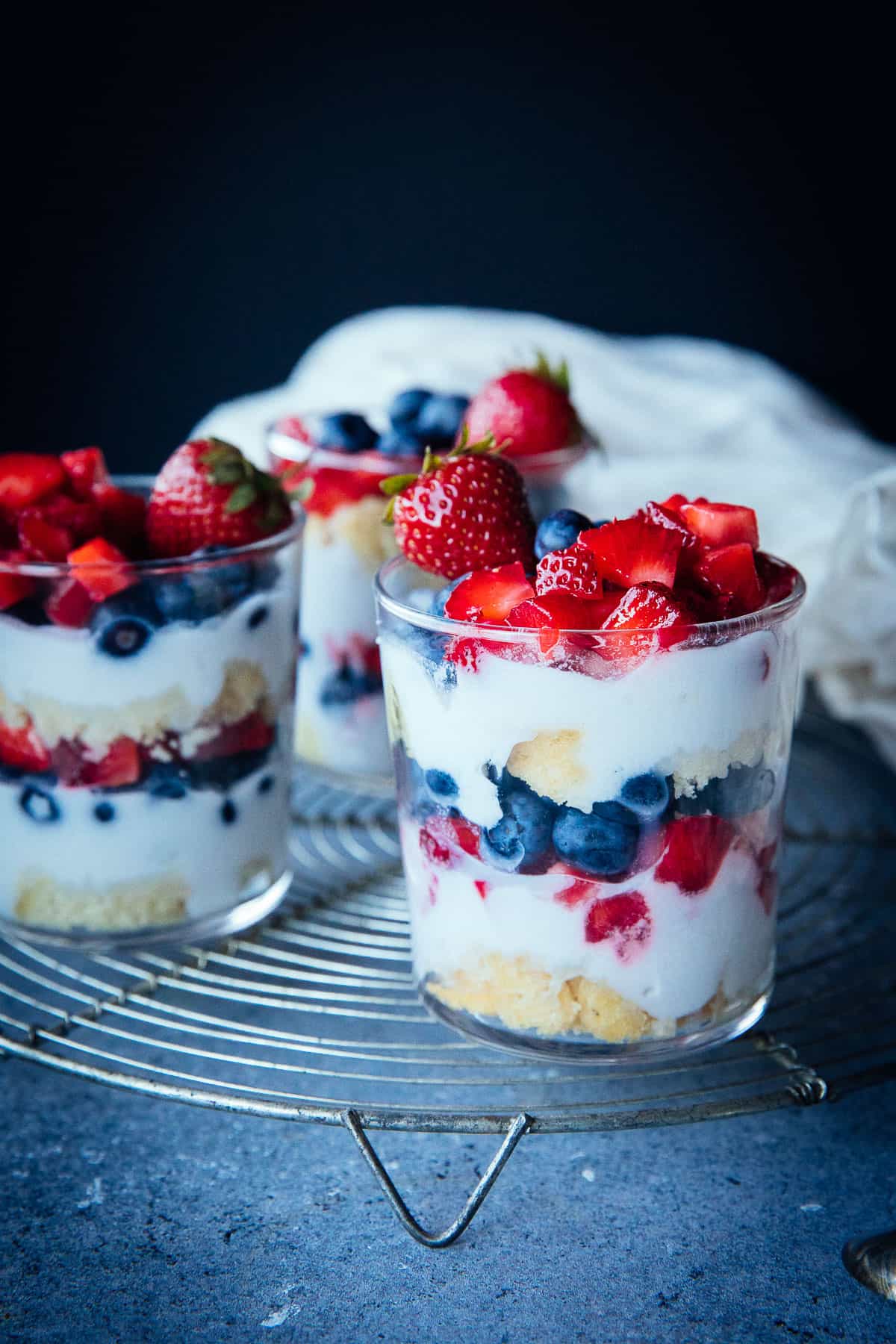
I chose a veganized vanilla cake recipe that uses the reverse creaming method where eggs are added in the final step.
With reverse creaming, eggs are often added last and are used more for emulsification than leavening or structure.
This means that we can also test common egg substitutes such as baking powder or mineral water that can't be whipped into peaks like aquafaba.
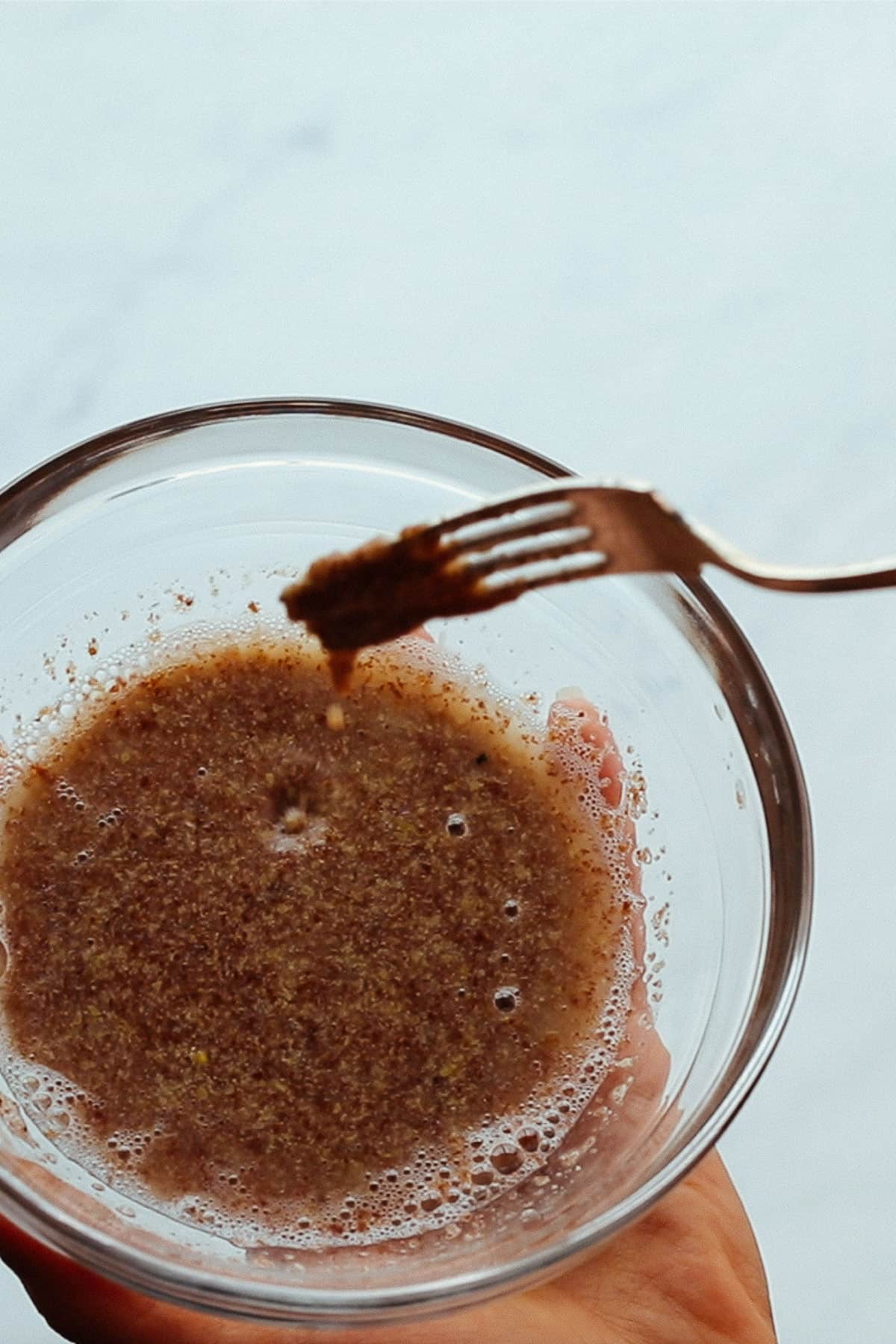
Before we get to the test, note that we didn't feature flaxseeds, chia seeds, or applesauce.
Even though these popular replacers do work in numerous recipes for many people, I don't want any changes in the texture (i.e. flaxseeds) or flavor (e.g. applesauce) in what I'm making.
So if you have go-to recipes made with any of these substitutes, that's great! As long as they work for you, keep using them. 🙂
Popular Egg Replacers:
Here are what we tested:
- Liquid (Non-Whipped) Aquafaba
- Whipped Aquafaba
- Aquafaba + Arrowroot Starch
- Aquafaba + Cornstarch
- Whipped Aquafaba + Cornstarch
- Oil + Baking Powder + Water
- Mineral Water
- Vinegar & Baking Soda

Each of these options was used to create a different cake batter. The weights were kept the same throughout, including in the muffin tin. Speaking of which—each cupcake may have been baked slightly differently due to the nature of baking in a muffin tin. The corner pieces did get browner than the middle ones, but they weren't significantly uneven.
Why Use Aquafaba?
You may be wondering why five of the eight egg substitutes we tested have aquafaba in them.
If you indeed are curious, I have a way-too-detailed article on the origins and applications of it.
But In short, aquafaba is popular because it can provide leavening and structure even though only 1% of it is made of protein. This is likely because aquafaba has saponins.

Nobody knows exactly why aquafaba can do what an egg does. But the famous food scientist Harold McGee has a pretty good idea!
He hypothesizes that the dissolved starch and saponins in the bean broth slow the collapse of foam and stabilize bubbles. The word saponin itself comes from the Latin for soap: sapo.
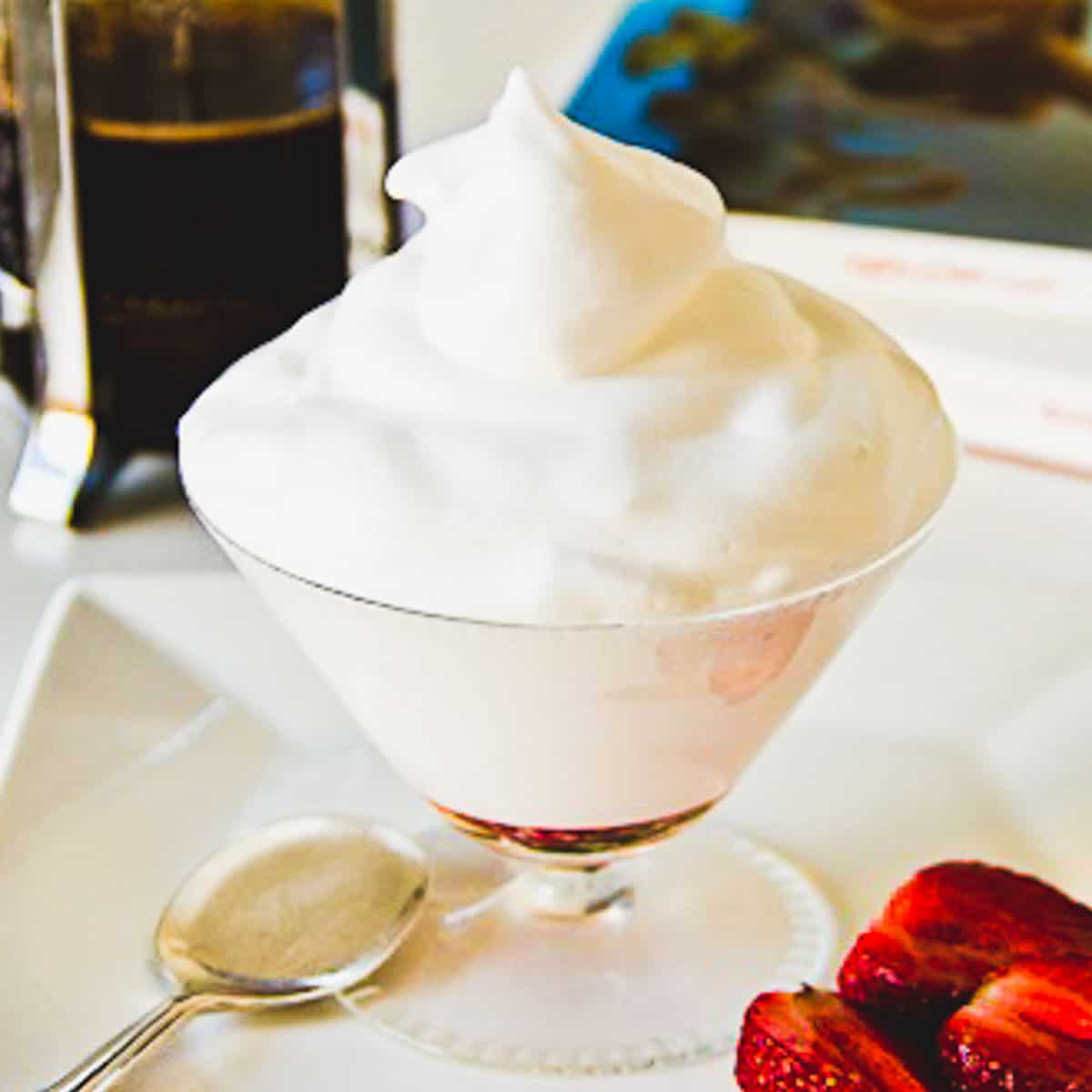
McGee's hypothesis makes perfect sense to me. Because the rest of the world has been using saponins in food for a long time!
Lebanese cuisine has had egg-free meringues (natef) made with saponaria officinalis, also known as soapwort, for centuries.
Even though there are virtually no proteins in soapwort that would help with denaturing and provide structure when making new bonds, the saponins basically work in a very similar way.
Turks use soapwort extract in the marshmallow-like Turkish delight called "saray lokumu" and in tahini halva to strengthen its structure.
Professional Taste Test

Finally, the fun part: we taste-tested all the cakes. My husband is a Flavor Scientist who tastes things for a living, so his input was very detailed and helpful!
He had no idea which egg substitute was used in the cakes and I had mostly forgotten which number corresponded with which batter, so our test was almost double-blind!

🛒 Store-Bought Egg Substitutes
I didn't use any store-bought egg substitutes such as Bob's Red Mill, Just Egg, or Follow Your Heart because they aren't accessible to everyone.
The powder replacers tend to have a mixture of starches and baking soda in order to provide baking and leavening to baked goods.
Just Egg scramble is great for making omelets and fried rice, as well as spaetzle.
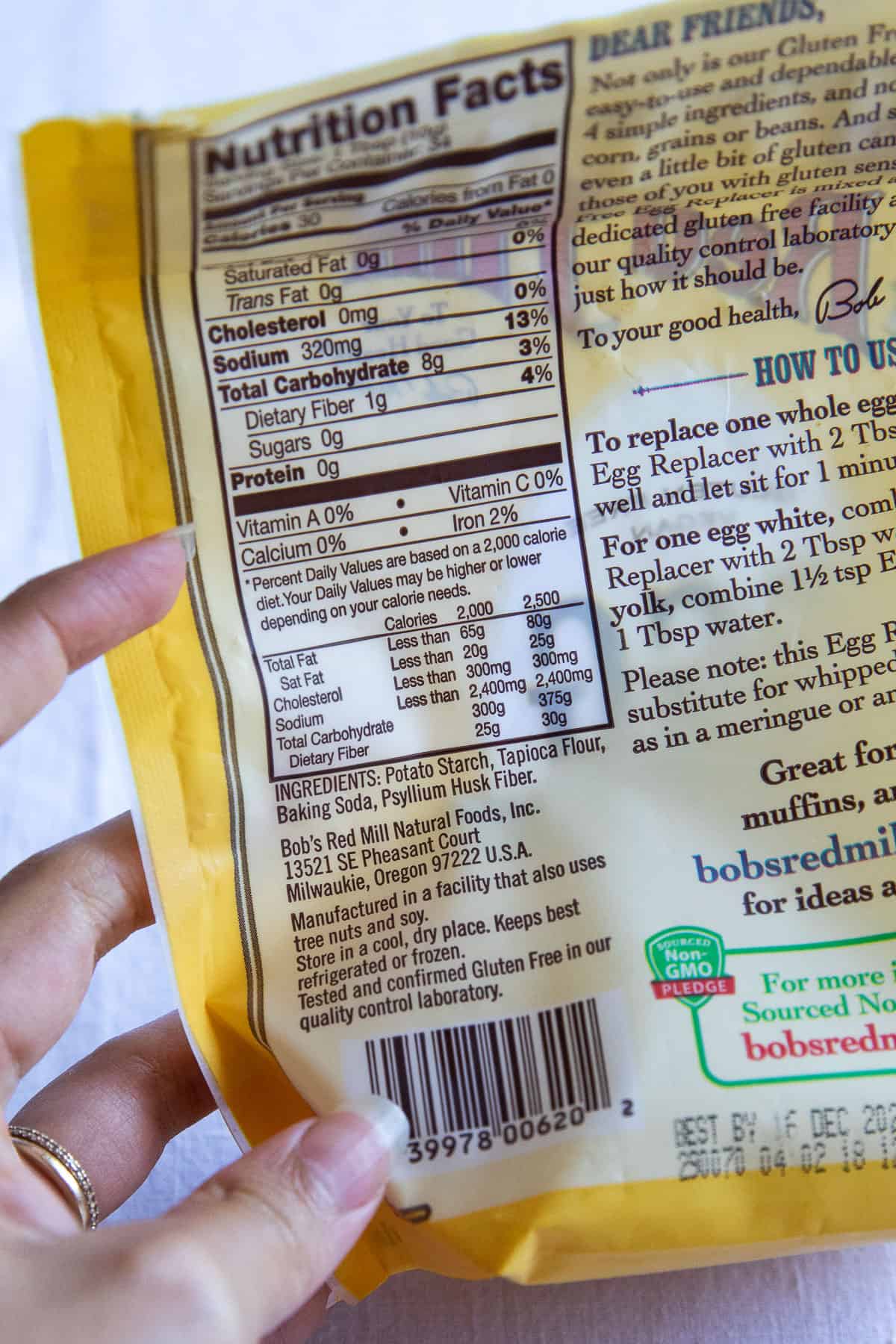
📋 Comparison of 8 Egg Substitutes
Each egg replacer weighed the same and was used along with sufficient additional vegan butter to replace the fat content from one medium egg.
1. Liquid (Non-Whipped) Aquafaba
The cupcakes made with plain aquafaba had a good flavor but lacked structure, crumbling easily.
This is likely because, on its own, aquafaba lacks the protein denaturing capabilities of eggs that result in an ideal cake texture. The saponins weren't strong enough to hold the cupcake together as well.
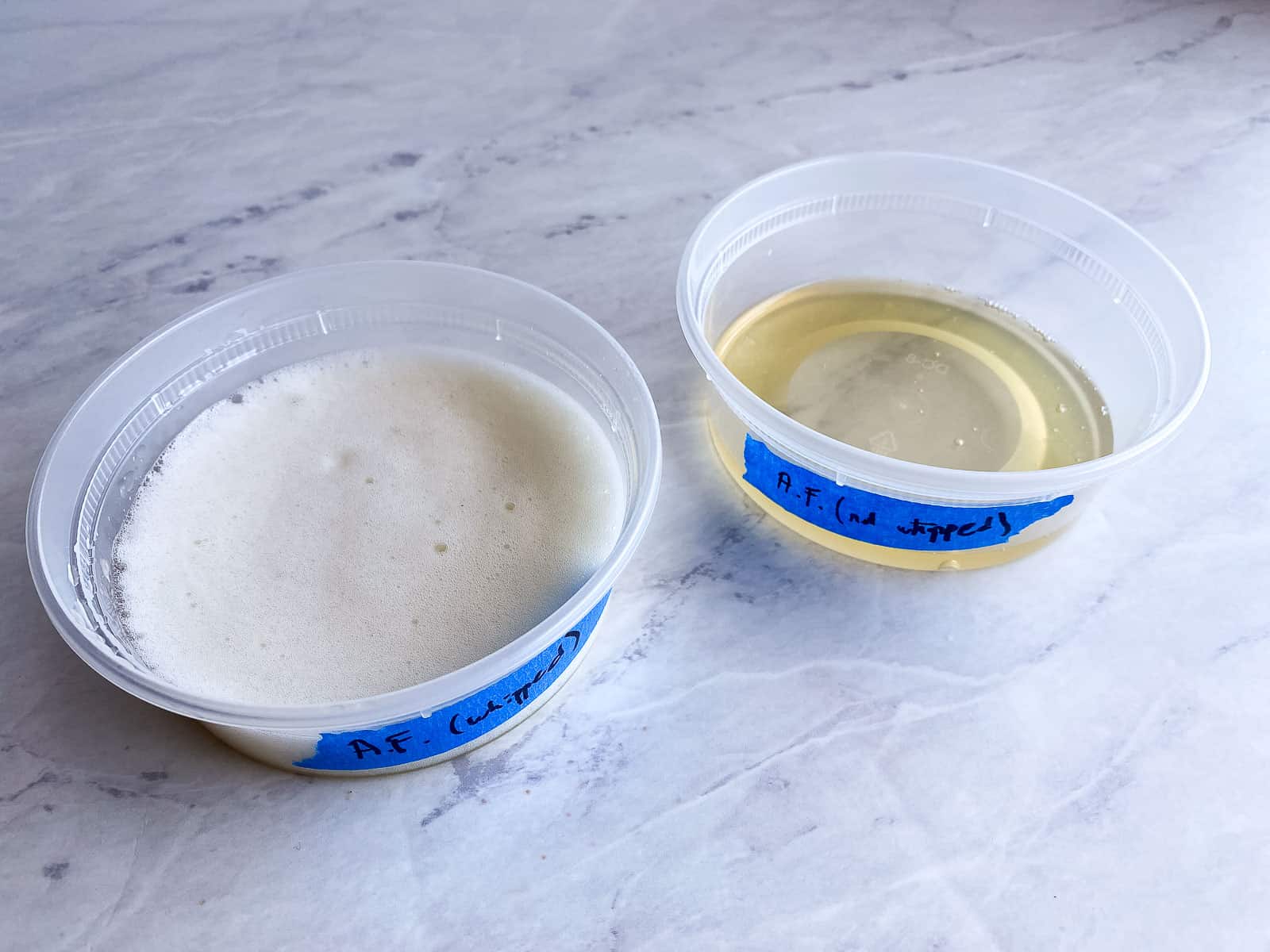
2. Whipped Aquafaba
With whipped aquafaba, we're taking more advantage of the saponins by creating air bubbles.
This is great for cakes completely aerated with egg whites such as angel food cake and chiffon cake, as well as flourless meringue or a dacquoise.

However, in this butter cake experiment, the aquafaba aeration was unnecessary and resulted in too light of a texture.
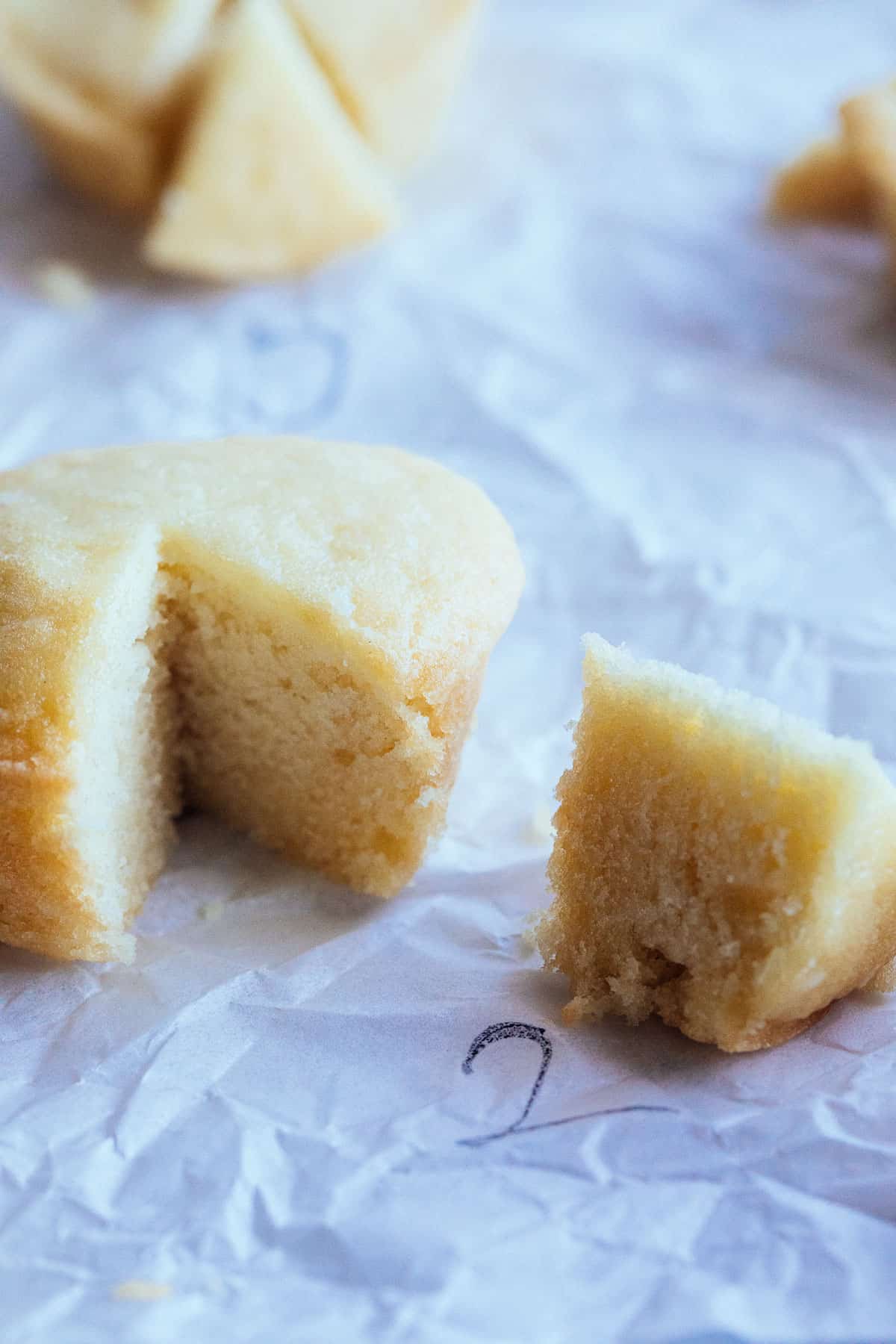
3. Aquafaba + Arrowroot Starch
Since aquafaba couldn't give enough structure, it's time to add starch. Arrowroot is made from the roots of a West Indian plant (Maranta arundinacea) and has a neutral flavor.
This mixture was our favorite! It created a robust structure without any off tastes, making it perfect to be used in layer cakes.
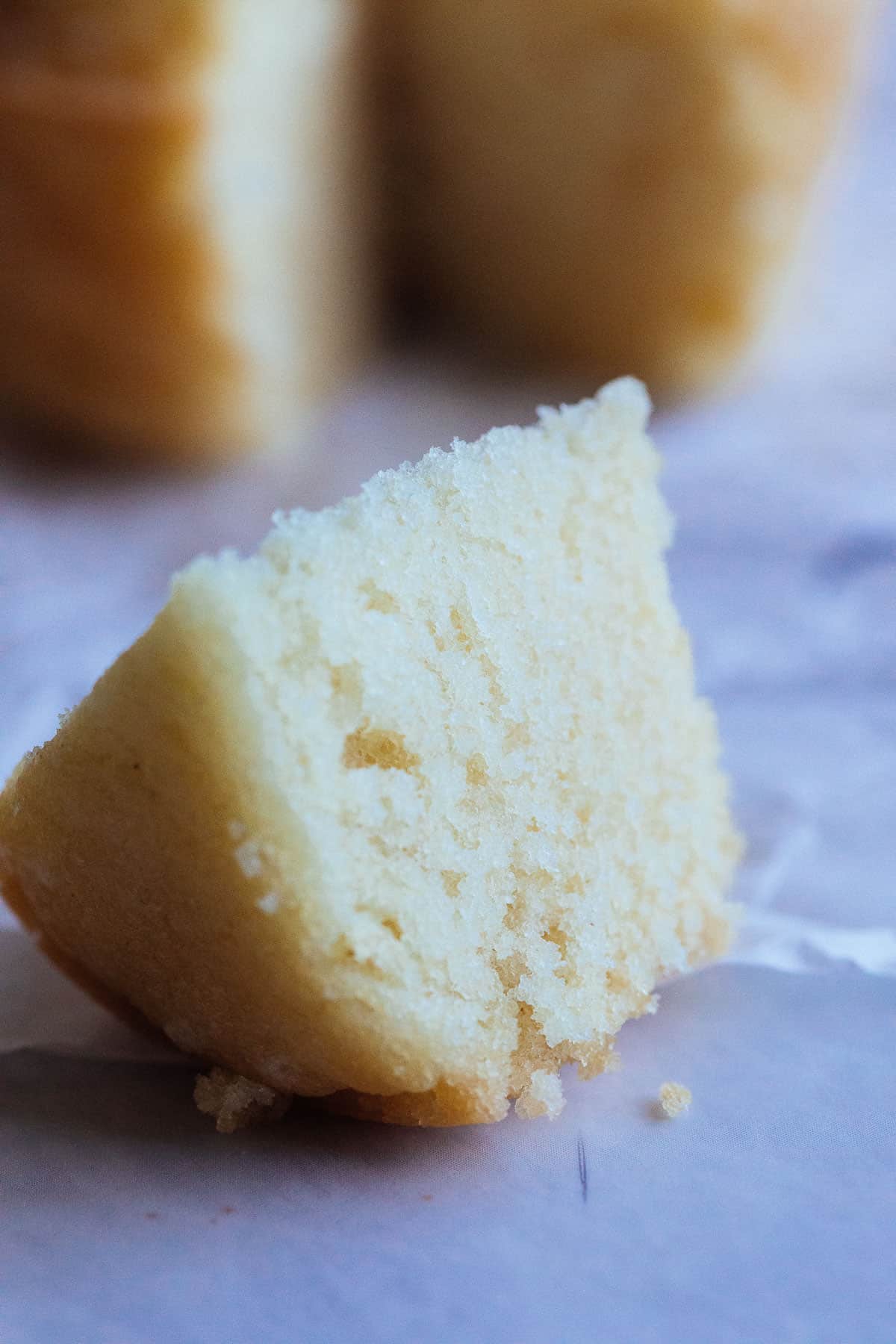
Note that arrowroot starch is said to create a slimy, off-putting texture when mixed with dairy. I haven't experienced this when baking with non-dairy (soy, almond, or oat) milks.
4. Aquafaba + Cornstarch
Unlike arrowroot starch, cornstarch does have flavor and doesn't freeze well, but we're using low enough quantities where these didn't matter.
It was very similar to #3 where the difference was almost impossible to notice, but the flavor scientist did detect a faint cereal-like flavor.
To me, they were identical. I would still recommend replacing eggs with this mixture, mainly due to its wider availability and lower cost.
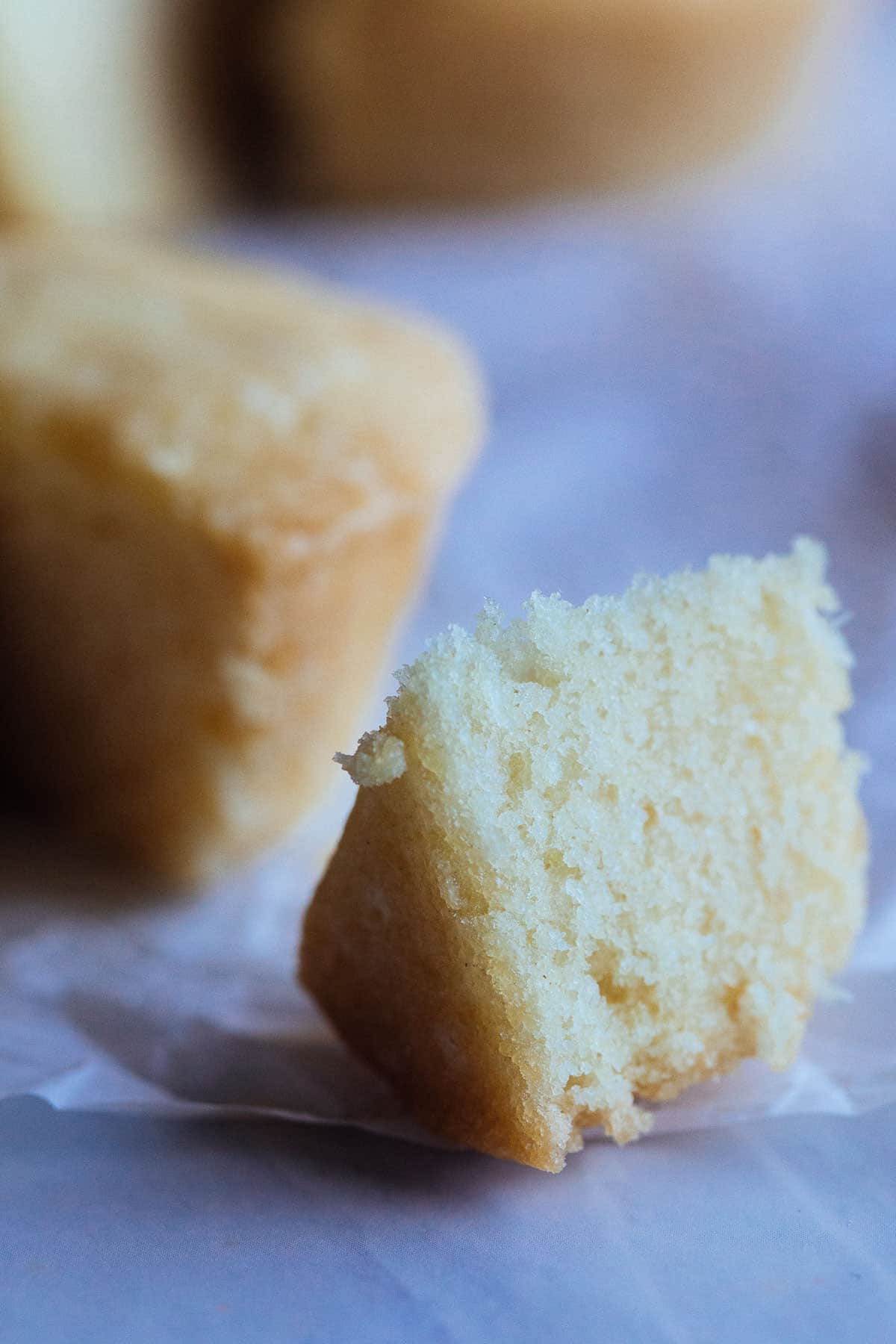
5. Whipped Aquafaba + Cornstarch
Similar to the cupcake in #2, this was a bit too airy. It held up better than using whipped aquafaba alone thanks to the starch.
This would be my go-to for an angel food cake!
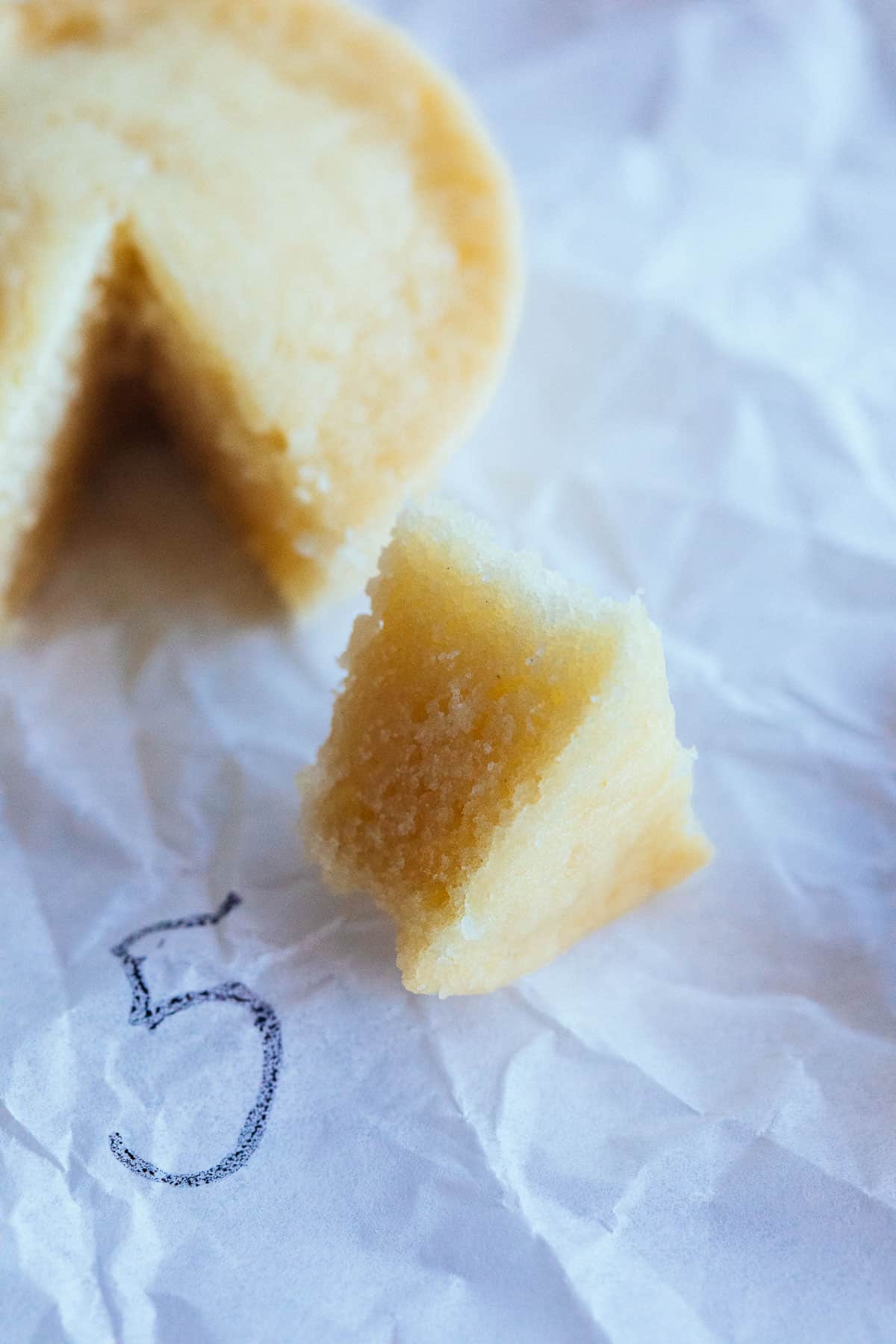
6. Oil + Baking Powder + Water
These cupcakes were moist but had very little chew—disintegrating too quickly. We could taste the baking powder as well. Not my favorite.

7. Mineral Water
Similar to #6, cupcakes made with mineral water to substitute the egg didn't have good enough structure. But at least they didn't have any off flavors!
8. Vinegar & Baking Soda
Some people swear by using vinegar and baking soda as an egg replacement, especially in depression cakes.
I'm pretty sure that's because the cocoa powder somewhat neutralizes or masks the horrible taste of the baking soda.

For me, it was a hard pass. It tastes extremely alkaline and awful.
I'm 100% positive that the outlet that recommended "replacing one whole egg with 1 ½ tablespoon of vinegar and 1 teaspoon of baking soda" never actually tried it in real life in a yellow cake or pancake.
Even in a pastry with very acidic ingredients, there's no way to neutralize this much baking soda without leaving an unpleasant aftertaste.
The taste aside, just take a look at the "structure" below. It's the only one that's basically exploded into a mess.

🥞 How to Replace Eggs in Anything
The American Egg Board claims that there is no single one-to-one substitution that can replace the multiple functional and synergistic properties of a real egg.
As true as this statement may be (for now), these substitutes come pretty close!
Here's how to substitute eggs as closely as you can in virtually every scenario:
Cakes & Pancakes
For cakes, replace each medium egg (45 grams) with a mixture of:
- 2 tablespoons (30 ml) of aquafaba*
- 1 tablespoon (7.5 grams) of cornstarch
- ½ tablespoon (5 grams) of vegan butter or vegetable oil—added along with the rest of the oils/butter in the recipe to compensate for the fat in eggs
If the recipe instructs whipping the egg whites first to create structure—such as in angel food and chiffon cakes—whisk the aquafaba by itself first (with a sprinkle of cream of tartar) and mix the cornstarch with other wet ingredients instead.
* Aquafaba can be the liquid from any cooked legume, but chickpea aquafaba from a can tends to have the right (i.e. the thickest) consistency.
If your aquafaba doesn't seem thick enough, you can always reduce it on the stove. Ideally, use unsalted or low-sodium aquafaba from BPA-free cans or Tetra-Pak packaging.

Ditto for pancakes. Here's a Serious Eats recipe that I use as a base to make fluffy aquafaba pancakes! I always add extra butter and cornstarch as recommended above.
Meringues & Macarons
For meringues, replace one whipped egg white with 2 tablespoons (30 ml) of aquafaba (whipped for longer for the same consistency), and add 1 tablespoon of cornstarch mixed in with the sugar.
A sprinkle of cream of tartar (less than ⅛ teaspoons per 3 "eggs") helps aquafaba come to firmer peaks much quicker.
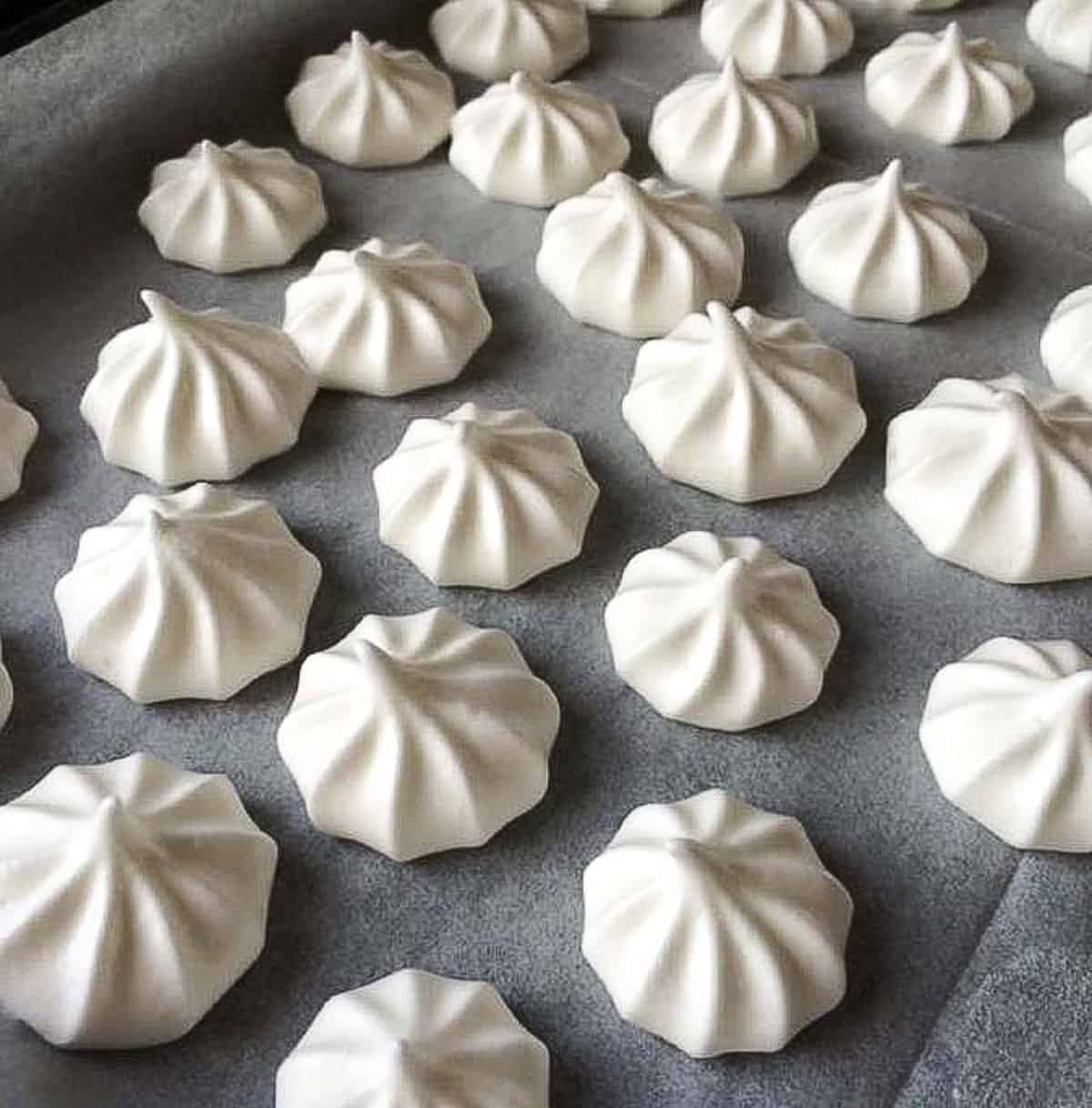
Although it is extremely difficult to find, soapwort extract is an excellent egg white substitute for meringues as well. Lebanese meringues (natef) are made exclusively with soapwort.
Eggless Cookies & Crêpes
For cookies and crepes, replace one egg by mixing one tablespoon (7.5 grams) of cornstarch with two tablespoons (30 ml) of water.
Eggs' main purpose in cookies and crepes is to add moisture and to act as a binding agent, so cornstarch works great.
You may substitute with arrowroot starch or potato starch as well.
For crepes, I also like to use a small drop of vegan yellow food coloring as well because we eat with our eyes too!
Seeing the familiar yellow hue makes vegan crepes even more appetizing.
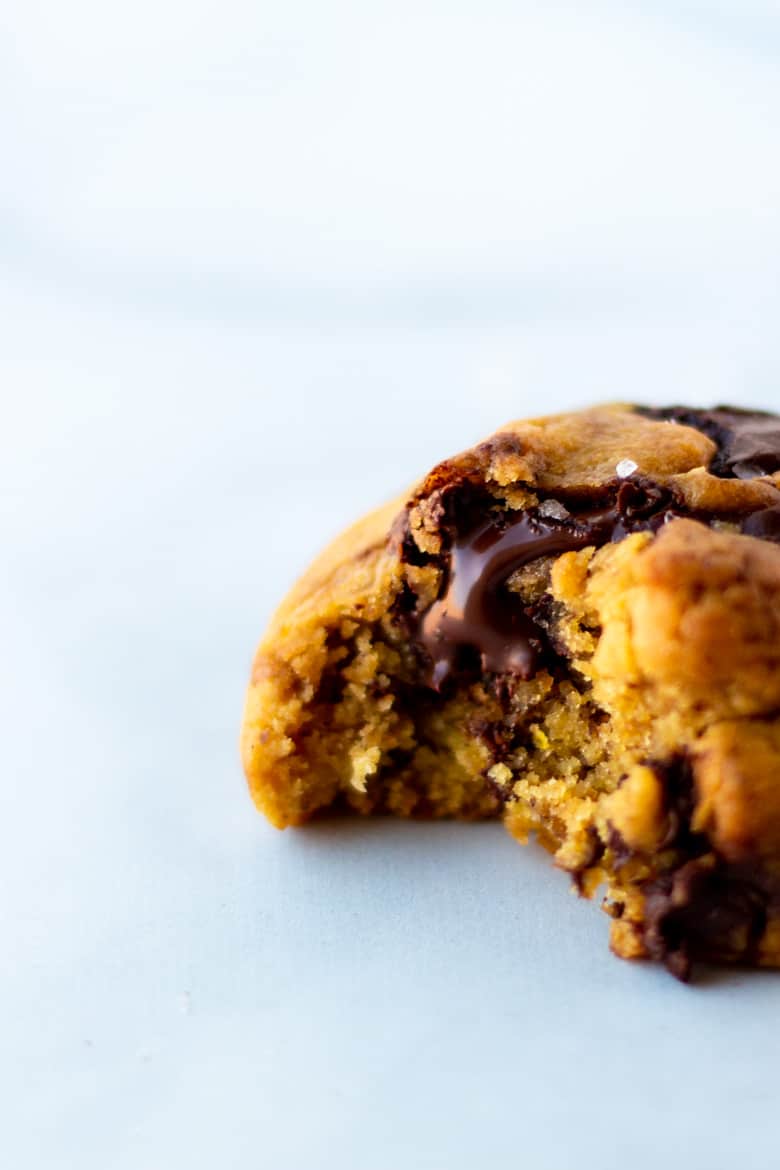
Custards
Substitute eggs in a custard simply by adding cornstarch along with the non-dairy milk.
I am not specifying an exact amount because each custard recipe is different and many are made without the use of eggs anyway!
Similarly to eggless crepes, if you're missing the yellow-orange hue of an egg custard—add a small drop of yellow food dye into the custard. Turmeric works too, but it's easy to add too much of it where you can differentiate its taste.
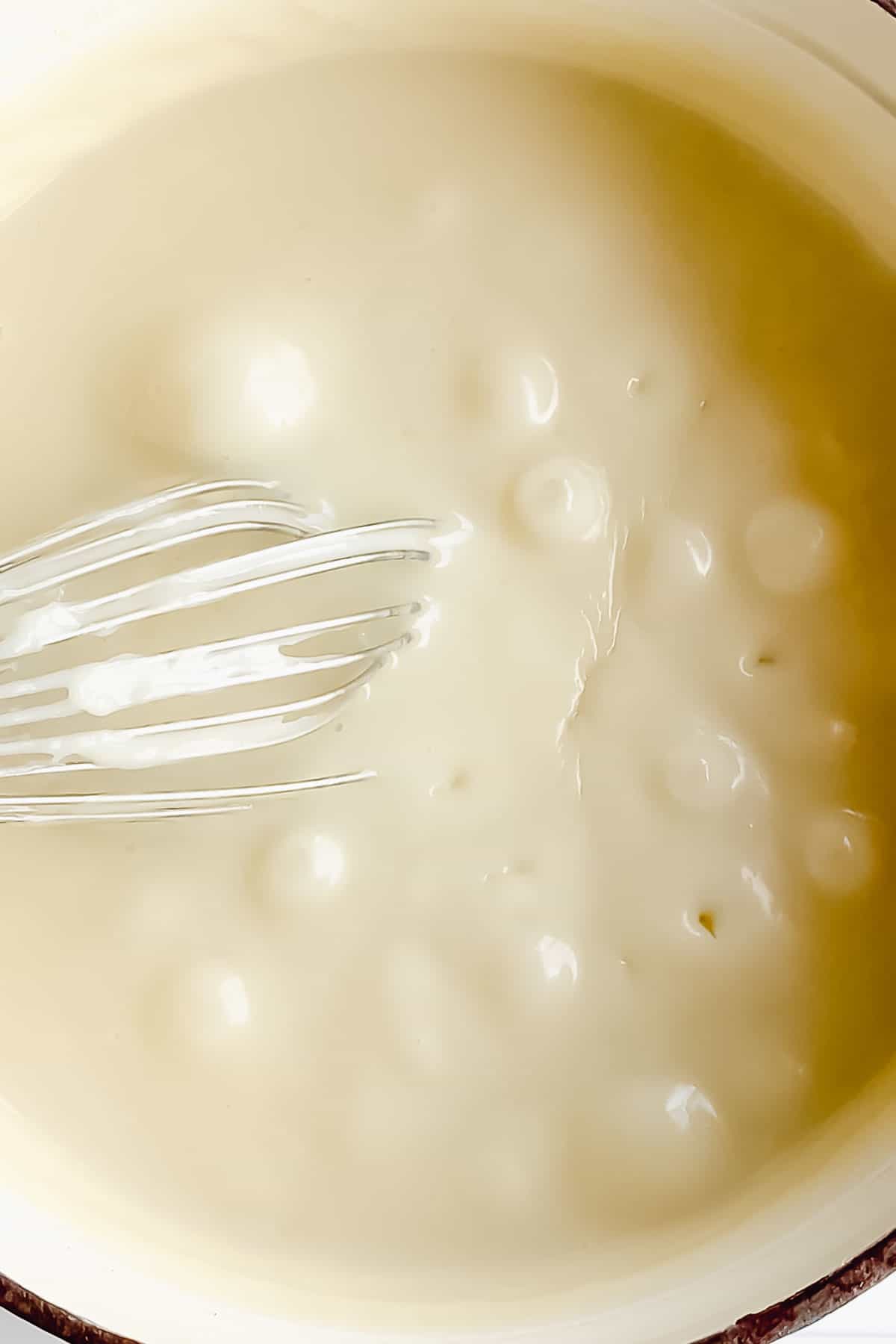
Spaetzle
My husband loves making vegan spaetzle, a quick German noodle dish traditionally made with eggs. He uses chickpea flour—2 tablespoons of chickpea flour or besan mixed with 2 tablespoons of water to replace one egg.
Just Egg also works great in spaetzle!
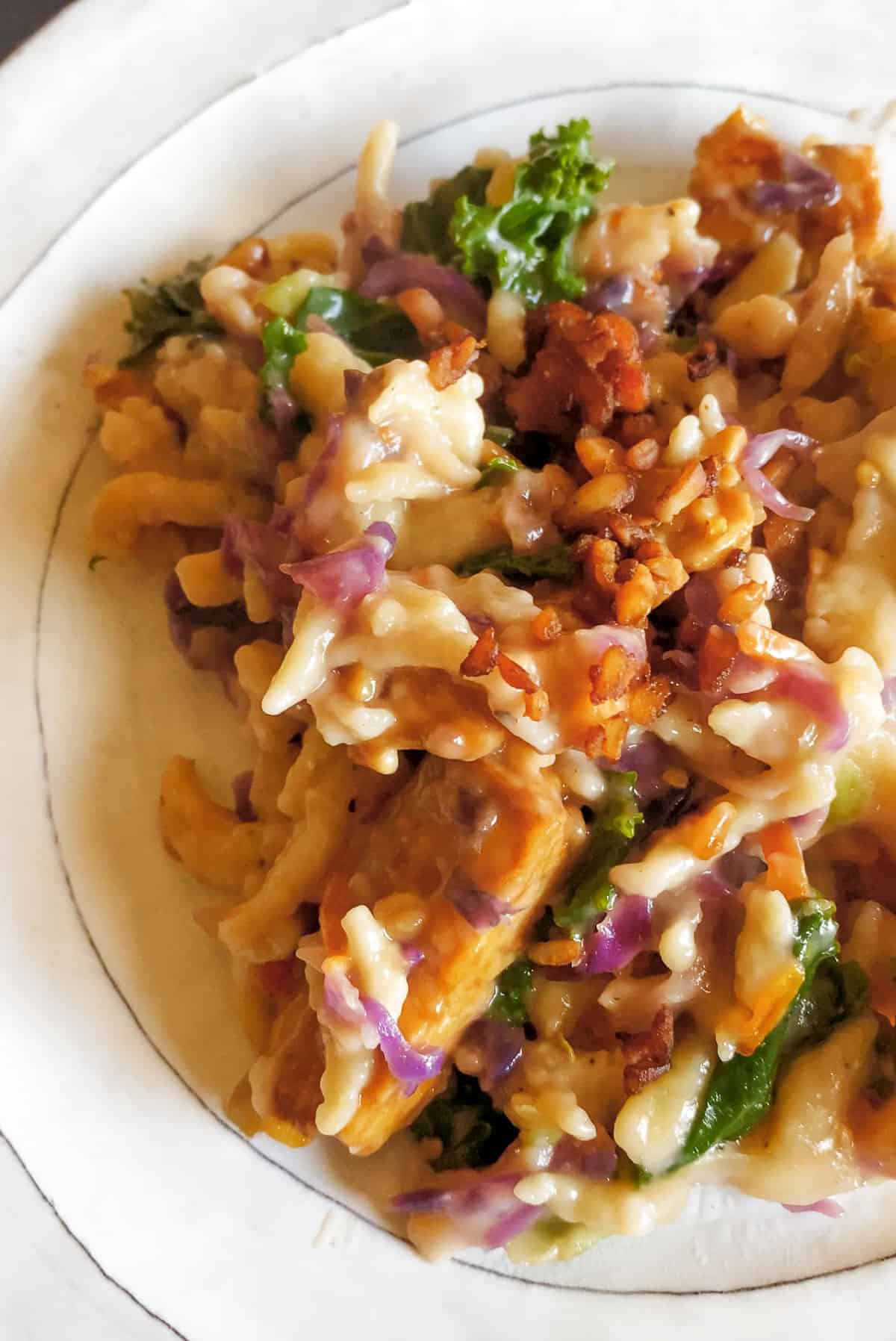
Egg White in Cocktails
In cocktails, replace each egg white with 30 grams of aquafaba with ½ teaspoon of sugar and whip to desired consistency.
Since aquafaba does have a bean-like taste, especially when consumed raw, you really need the sugar to mask it.
Scrambled "Eggs", Eggless Omelets, and Quiche
Most of us have heard of scrambled tofu. Simply crumbled-up soft regular or silken tofu works great as a vegan substitute! My favorite is to use it in this Turkish shakshuka dish:
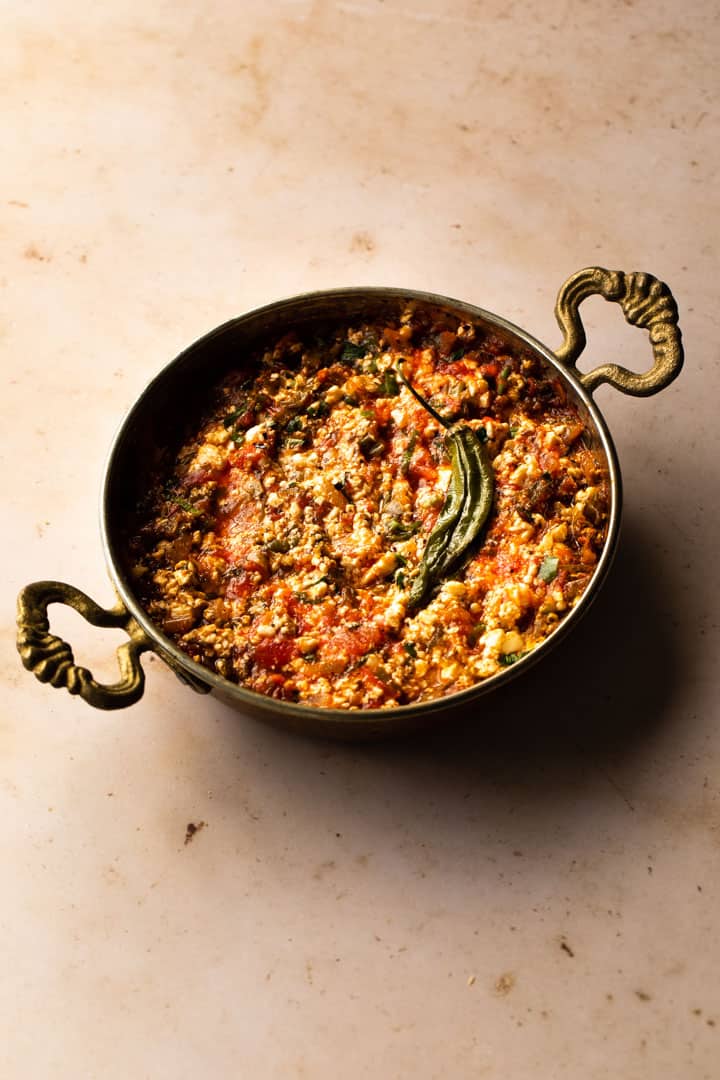
Though to make an omelette or a quiche, you need something a bit more homogenous than crumbled tofu. In those dishes, we use chickpea flour!
Here's Turkish pizza made with a chickpea-herb quiche:

Sunny Side Up Eggs or Runny Yolks
If you'd like to replace egg yolks that are undisturbed (as with sunny-side-up eggs or runny egg yolks on a carbonara), you'll need to do far more work.
Here's a vegan egg yolk recipe that uses spherification, a molecular gastronomy method that requires special ingredients.

Replacing Egg Yolks or Egg Whites
Yolk:
Replace an egg yolk with:
- 1 tablespoon (7.5 grams) of cornstarch mixed with 2 tablespoons of water
- ½ tablespoon (5 grams) of vegan butter or vegetable oil—added along with the rest of the oils/butter in the recipe to compensate for the fat in eggs
Egg White:
Replace each egg white with 2 tablespoons (30 ml) of aquafaba and whip until desired consistency if whisking is listed in the recipe.
If the egg whites in the recipe are being used to hold other ingredients together (e.g. binding batters), mix in 1 tablespoon of cornstarch as well.
Is the egg white being replaced is being consumed raw, such as in a whiskey sour? Mix in a dash of sugar to mask the taste.
❓Egg Replacement FAQs
Egg allergies are often the most common reason to want to replace eggs. Many also simply don't choose to include eggs in their diet due to a vegan lifestyle or health concerns related to cholesterol or salmonella risk.
One medium chicken egg weighs approximately 45 grams and has 70 calories from 6 grams of protein, 5 grams of fat (1.4 gram of which is saturated), and less than 1 gram of carbohydrates. Almost 75% of an egg's weight is from water (33 grams). Of the 70 calories in a medium-sized egg, 62% are from fats, 36% are from protein, and the remaining 2% are from carbohydrates.
Eggs can provide leavening, structure, binding, emulsification, shortening, moisture, as well as flavor and a yellow hue in baking.
Aquafaba is popular because it can provide leavening and structure even though only 1% of it is made of protein. This is likely because aquafaba has saponins. The famous food scientist Harold McGee hypothesizes that the dissolved starch and saponins in bean broth slow the collapse of foam and stabilize bubbles.
However, since aquafaba has only 1% protein, its denaturing properties are often inadequate to replace an egg for binding purposes. The addition of a starch solves that problem.
Replace each medium egg (45 grams) with a mixture of:
2 tablespoons (30 ml) of aquafaba +
1 tablespoon (7.5 grams) of cornstarch +
½ tablespoon (5 grams) of vegan butter or vegetable oil—added along with the rest of the oils/butter in the recipe to compensate for the fat in eggs
Replace an egg yolk with:
1 tablespoon (7.5 grams) of cornstarch mixed with 2 tablespoons of water +
½ tablespoon (5 grams) of vegan butter or vegetable oil—added along with the rest of the oils/butter in the recipe to compensate for the fat in eggs
Replace each egg white with 2 tablespoons (30 ml) of aquafaba and whip until desired consistency if whisking is listed in the recipe. If the egg whites in the recipe are being used to hold other ingredients together (e.g. binding batters), mix in 1 tablespoon of cornstarch as well.
If the egg white being replaced is being consumed raw (such as in a whiskey sour), mix in a dash of sugar to mask the taste.
For cookies, replace one egg by mixing one tablespoon (7.5 grams) of cornstarch with two tablespoons (30 ml) of water.
Eggs' main purpose in cookies and crepes is to add moisture and to act as a binding agent, so cornstarch works great. You may substitute with arrowroot starch or potato starch as well.
In order to have a high enough concentration of saponins and free starch, aquafaba should be thick. Canned chickpea brine works very well. If your aquafaba isn't thick enough, you may reduce it on the stove.
🍳 Delicious Recipes Made with Egg Replacers
Here are some delicious recipes made with egg replacements:
Was this egg substitution guide helpful? I'd love to hear your thoughts! Please comment and leave a star🌟 rating below 🙂
Print📖 Recipe
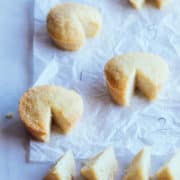
Best Egg Substitute
- Total Time: 2 minutes
- Yield: Replaces 1 Medium Egg 1x
- Diet: Vegan
Description
Complete with a taste test by our resident Flavor Scientist, we found the best egg substitutes after trying out all the popular options. From cakes to spätzle, read on to find out the best way of replacing eggs in virtually every scenario. You'll use these vegan egg substitutes all the time!
Ingredients
For Cakes & Pancakes (per 1 medium whole egg)
- 2 tablespoons (30 ml) of aquafaba*
- 1 tablespoon (7.5 grams) of cornstarch
- ½ tablespoon (5 grams) of vegan butter or vegetable oil—added along with the rest of the oils/butter in the recipe to compensate for the fat in eggs
For Meringues (per 1 whipped egg white)
- 2 tablespoons (30 ml) of aquafaba
- 1 tablespoon of cornstarch (mixed in with the sugar)
For Cookies & Crepes (per 1 medium whole egg)
- 1 tablespoon (7.5 grams) cornstarch
- 2 tablespoons (30 ml) water
- ½ tablespoon (5 grams) of vegan butter or vegetable oil—added along with the rest of the oils/butter in the recipe to compensate for the fat in eggs
- optional: a drop of vegan yellow food coloring
Spaetzle (per 1 medium whole egg)
- 2 tablespoons of chickpea flour or besan
- 2 tablespoons (30 ml) of water
Egg White in Cocktails (per 1 egg white)
- 2 tablespoons (30 ml) of aquafaba
- ½ teaspoon of sugar
Egg Yolk
- 1 tablespoon (7.5 grams) cornstarch
- 2 tablespoons (30 ml) water
- ½ tablespoon (5 grams) of vegan butter or vegetable oil—added along with the rest of the oils/butter in the recipe to compensate for the fat in eggs
Runny Egg Yolk
Instructions
- Mix each ingredient except the butter in a small bowl and let sit for a minute before adding it in. Add the butter along with the other fat ingredients being used in the recipe.
- When replacing whipped egg whites, make sure to whisk for longer to reach the same consistency. A sprinkle of cream of tartar (less than ⅛ teaspoons per 3 "eggs") helps aquafaba come to firmer peaks much quicker.
- If the recipe instructs whipping the egg whites first to create structure—such as in angel food and chiffon cakes—whisk the aquafaba by itself first and mix the cornstarch with other wet ingredients instead.
Notes
Aquafaba can be the liquid from any cooked legume, but chickpea aquafaba from a can tends to have the right (i.e. the thickest) consistency. If your aquafaba doesn't seem thick enough, you can always reduce it on the stove. Ideally, use unsalted or low-sodium aquafaba from BPA-free cans or Tetra-Pak packaging.
- Prep Time: 2 minutes


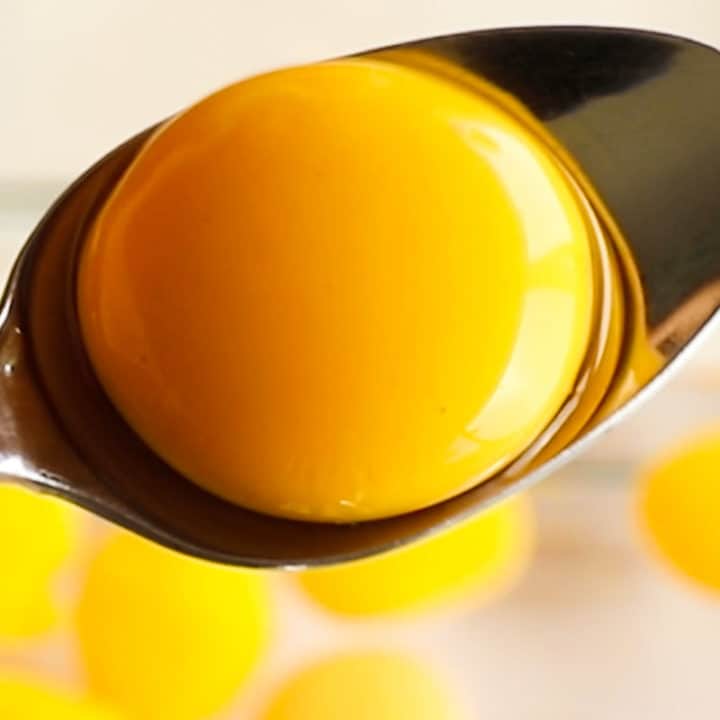
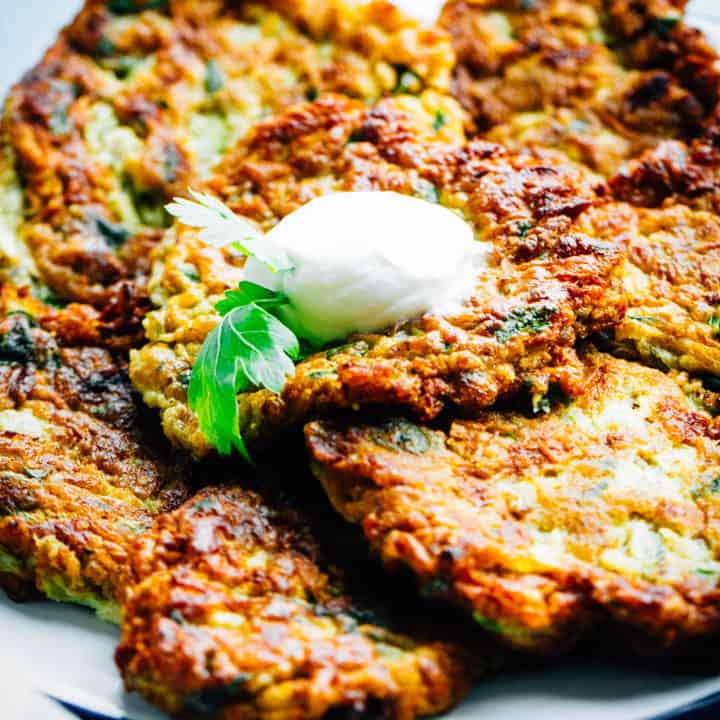
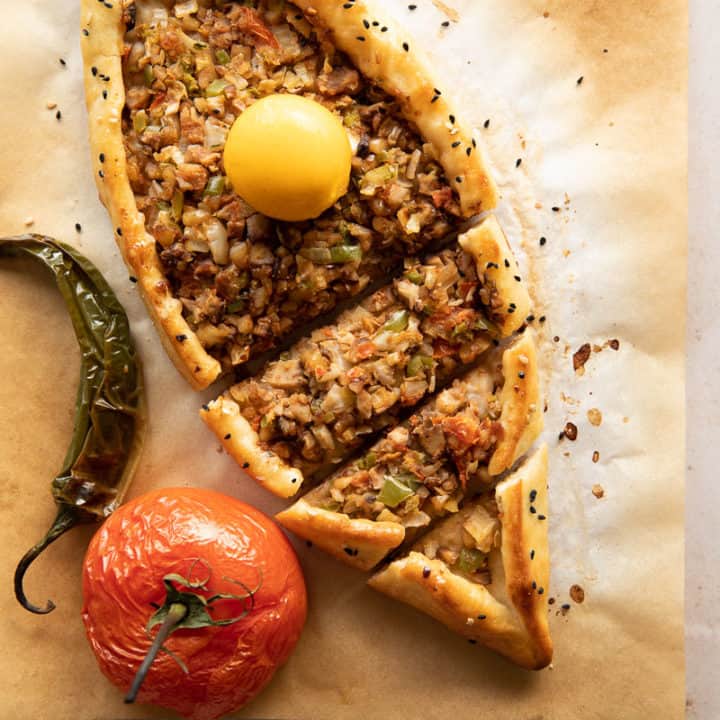

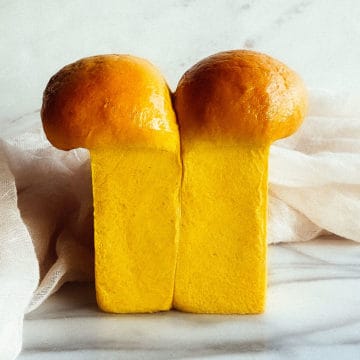
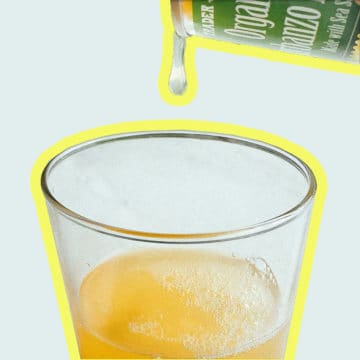
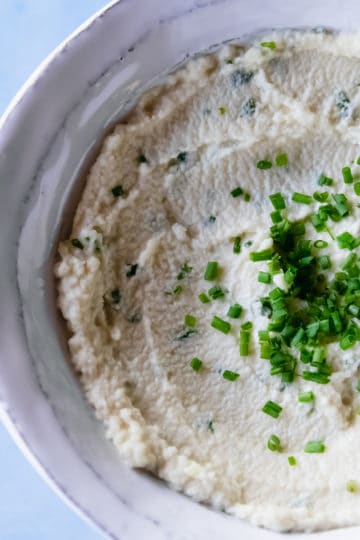
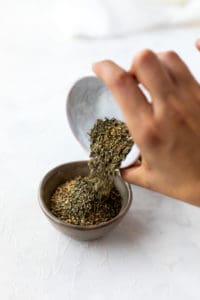
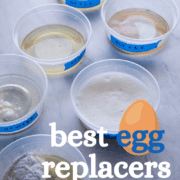
Comments
No Comments